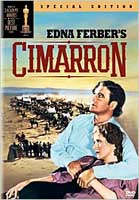 BUY IT AT AMAZON:
BUY IT AT AMAZON:
CLICK HERE!
STUDIO: RKO Pictures
MSRP: $14.99
RATED: NR
RUNNING TIME: 123 Minutes
SPECIAL FEATURES:
•
Vintage Short – “The Devil’s Cabaret”
•
Classic Cartoon – “Red-Headed Baby”
Westerns have had a tough sell, being the wholly American genre that produced greats and downright loathsome ones. As is the case of famed playwright Edna Ferber’s (Giant, Come and Get It, Showboat) own Cimarron, the sole Western awarded Best Picture until Dances with Wolves. It’s also considered to be one of the lesser Best Picture winners, alongside a recent mediocre multi-cultural Los Angeles drama, and a movie I love: Cecil B. DeMille’s spectacularly epic Greatest Show on Earth. However, what sets the film apart from other inwardly tales of the frontier is its scope – not many have tried and semi-succeeded with such lackluster fanfare.
The Flick

Obviously, he’d never been to Oxaca before.
1930 was a strange year with the arrival of sound in The Jazz Singer to our multiplexes. The various impositions it quickly heaved upon the motion picture industry were tremendous. Causalities were inevitable; often times while watching older films Actors will lean towards potted plants, accessible coat racks and other stationary items where hidden microphones were located. The mighty word threw everything into a stodgy tizzy and most results were wooden and entirely suspect. Possibly you already knew that.
Credit should be given to those who broke free from such sturdy molds experimenting with more pressing techniques. As it so happens, Cimarron is one of those films. Not only is it quite impressive on a wholly technical level, but the artistry and craft prevalent throughout its entire running time is subjected to several scenes of awesomeness not unlike the first time you stumbled onto your Mom’s ‘other’ magazine collection about firemen.
The pontificating Richard Dix (whose eyeliner is a bit too prevalent throughout the narrative) is Yancey Cravat. His prime objective is like John B. L. Soule’s call for arms: Go West, young man, and grow with the country. Naturally such a development opens up in 1889: the Oklahoma Land Rush. Leaving family behind, Cravat rides roughshod into the wild flat yonder – determined to make it as a renaissance man. First it’s through a newspaper: setting up the Oklahoma Wigwam in the thriving town of Osage. Then it’s as a preacher, waxing holistic during those few spare moments of demanding equal rights for Indians, Women, and Blacks in his weekly editorials. His attorney-at-law position calls as well, but these are reality’s side jobs while ushering in a new level of humanitarianism throughout the annals of Oklahoma and Osage’s fledgling metropolitan history.
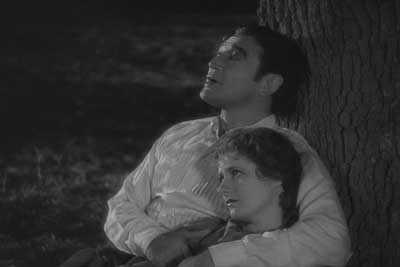
You mind if I sing some Eazy-E? It’s fitting after what we did.
Wanderlust also plays a tremendous factor in shaping Yancey’s destiny. Unable to stay put for more than 5 years in any one spot (“he’s the type of man that builds the world” quotes merchant Sol Levy), Dix’s Cravat is subjected to hair-brained schemes at the expense of those who love and care for him. His resourceful wife, the pioneering Sabra (Irene Dunne) is the one subjected to the most hardships; forced to clothe, feed, and generally take care of Yancey’s daily work as he leaves for other Land Rushes, the Spanish-American War, and even a general dislike for staying put. Nowadays we’d refer to this as ADD and send good old Yancey into the loving arms of Tom Cruise’s most hated Ritalin.
As a whole the movie suffers from a heavy reliance on the main plot of Cravat and doesn’t leave much time for Sabra’s own upheavals throughout Yancey’s personal discretions – in terms of him up and leaving her at the most inopportune times. Sabra and her spawn are introduced no less than several times and the silent still-like interludes that inform us of what’s occurred during 3 years, 5 years, and well over 10 years serve as a sort of skewed reliance on moving the plot along. Because of such, it suffers. The story, based on Edna Ferber’s own slice of Americana (she’d delve a little deeper in the masterpiece Giant), has uneven moments as a whole. I believe they jump right back into the half-baked qualities of Sabra’s own screentime. There just isn’t enough there to sustain more than a halfhearted attempt to even care. Especially when she’s married to travellin’ man Yancey Cravat.
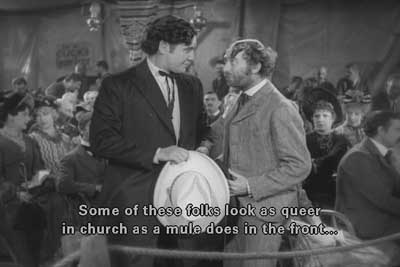
Oklahoma always had to be more progressive than the rest of us.
Richard Dix’s over-the-top moralizing preachy performance is one for the ages. He’s setting the bar for others to follow and throughout, he manages to actually become one of the truly loathsome dicks I’ve watched in early cinema. He’s laughably atrocious to his family. He tucks tail and runs to whatever ambitiousness that comes rumoring his way – without any regard to the consequences. He just doesn’t seem to care, as evidenced when he leaves for 5 years to fight the Spanish-American War, only to return, greet his wife and immediately run off to defend some harlot being run out of town on general, moral principles. If I were his wife he’d be kicked, hard, curb side. Granted, a lot has changed since the early 1900’s. Wives surely had to deal with these sort of situations, and now, in a more modern age, it just looks unbelievable. Yancey is truly one of those unscrupulous characters who do one thing, say another, and even manage to wax poetic in the meantime. In short, his prickly qualities are awe-inspiring.
Another ‘I can’t believe it’ moment comes in the form of the Cravat’s servant Isaiah. His stereotypical “massah” performance is cringe worthy. The racism just seeps right off the screen and into your lap. One scene has Isaiah getting truthfully excited because Yancey point out a seller’s cart of watermelons at his new home. And that’s just the beginning. Times have certainly changed, and with good reason. It’s hard to take most of the moralizations in the film when developments like the character of Isaiah bog it down considerably time and again. Horrendously dated, I can’t help but wonder if anyone would see the positive instances of portraying blacks like this, unless they work in the current Presidential Administration.
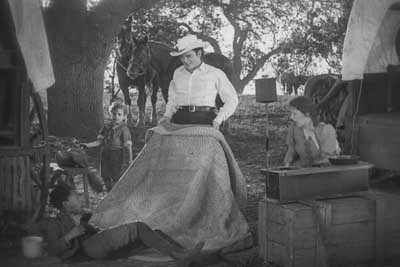
"Well, looks like we’ll have to eat him."
Wesley Ruggles, the film’s director, balances those shocking scenes with what can honestly be considered as a massive leap forward in cinema when compared to the restraints sound placed on filmmakers of the era. There are shots, more specifically in the opening record of the Oklahoma Land Rush, were the camera tracks, swoops, and even does things I couldn’t even fathom. The Land Rush itself is of Hollywood legend – you honestly haven’t quite seen anything like it; carts blustering through the plain, horses galloping towards destiny, and gallons of dirt tossed up for a Hail Mary of greatness. Filmed in an Academy aspect ratio – 1.37:1 – Ruggles somehow manages to make his imagery transcendent, bouncing right off and exploding outward.
Additionally, there is a sweeping track backwards across the Cravat family table during the opening where I couldn’t help but be amazed at the artistry. It’s such a simple move, but there’s power within. Appropriately, there are moments later on where Yancey and Sabra walk Osage’s dusty streets; the camera tracking alongside while hundreds of extras stream about behind them, the life of a thriving boom town. These moments are astounding and a hard contrast to several more stodgy character pieces I’ve been subjected to (nonetheless, they are interesting footnotes in cinematic history). Their effect is not lost, rather muddled when considered in conjunction with the narrative developments.
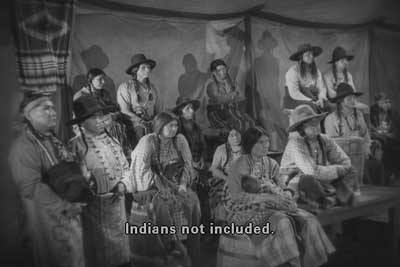
America’s stance was always welcoming.
Cimarron was remade in 1960 with the great guiding hand of Anthony Mann. While I haven’t seen it (yet, it’s going straight on my growing list), I’ve been assured it covers the same themes with much punchier intensity. Check that one out if you end up liking this early version. As for the original, from the filmmaking to the narrative, it’s quite a film stacked up against the rough and tumble westerns that followed. Most were indeterminately better; others not so much. But, in Cimarron, there’s a fairly entertaining film in there somewhere. One just has to look past some fairly early societal hang-ups.
8.2 out of 10
The Noise
Mono. It’s quite scratchy. Audial popping occurs throughout and the single soundtrack has a very muted sound. More distinctively was my need to actually turn up the volume to levels unheard of with other older Warner discs. One might assume that they put some work into a fairly unloved unremembered film. However, as it stands, it’s much like one’s sexual prowess – unfulfilled.
6.2 out of 10
The Look

"We’re gonna go out back so I can teach him to use
my knot and its working end!"
Scratched, rickety, faded, and fairly dirty – it’s a miracle that it’s still in as good as shape as it is. There are plenty of missing frames, causing unnecessary jump cuts and sound pops at all levels of the plot. I can only give some benefit of the doubt to Warner’s own Home Video Department and their DVD engineers with working with what they have. It’s not good, but it’s not unwatchable either. Arguably one of Warner’s most undistinguished transfers I’ve ever watched.
6.2 out of 10
The Goodies
For a Special Edition that won Best Picture, it’s not quite special enough. There is no commentary track, no theatrical trailer, even no publicity stills from anything. No mention of Oscar programs or even a featurette on its significance to the Academy or even the Western genre. That’s almost troubling, most likely because the people behind Cimarron’s digital endeavor thought no one cared. I did!
What you do get is a Vintage Musical Short – ‘The Devil’s Cabaret’ (runtime: 16:23). It’s a fairly conventional two-strip Technicolor short showcasing a Busby Berkley style musical number with a large Satan head and plenty of women showing their gams. The plot is arbitrary compared to the dance number, although the character actor playing the Devil is very Vincent Price-like in his features. The short is light and breezy and filled with plenty of mugging opportunities, especially via the Bob Hope-esque Howie Burns, the Devil’s right hand man.

"When did I get to Jersey City?! SIGN ME UP!"
Lastly, there’s a Classic Cartoon – ‘Red-Headed Baby’ (runtime: 6:38). It’s an early Merry Melodie that focuses primarily on a Baby toy that Santa is building. Once Santa retires for the night, it’s more of an excuse to have the toy sing a time-specific pop song for a cacophony of other playroom toys. The animation, while primitive, has its entertaining charm, but as a whole it’s fairly unmemorable. Just like my life.
6.7 out of 10
The Artwork
 I’d say it’s quite fitting. The scenes referenced in the front are of the main set-piece and of Yancey and Sabra pondering their future in Osage with the most optimistic abilities. Yancey does most of the pontificating in said scene, but it’s staged well. Particularly from the point of view of the audience, whose own hopes for the couple can be projected on the screen, and thus via proxy the DVD cover. Still, I don’t think many are going to be interested in such a film, being its age and relatively stodgy filmmaking capabilities (it’s –black and white! Merde!). Consider me hopeful, but uncaring towards you disrespectful bastards.
I’d say it’s quite fitting. The scenes referenced in the front are of the main set-piece and of Yancey and Sabra pondering their future in Osage with the most optimistic abilities. Yancey does most of the pontificating in said scene, but it’s staged well. Particularly from the point of view of the audience, whose own hopes for the couple can be projected on the screen, and thus via proxy the DVD cover. Still, I don’t think many are going to be interested in such a film, being its age and relatively stodgy filmmaking capabilities (it’s –black and white! Merde!). Consider me hopeful, but uncaring towards you disrespectful bastards.
7.6 out of 10